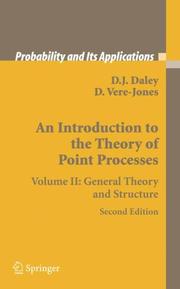| Listing 1 - 6 of 6 |
Sort by
|
Book
ISBN: 0471101222 Year: 1983 Publisher: Chichester Wiley
Abstract | Keywords | Export | Availability | Bookmark
 Loading...
Loading...Choose an application
- Reference Manager
- EndNote
- RefWorks (Direct export to RefWorks)
Queuing theory --- Stochastic processes --- Files d'attente, Théorie des --- Processus stochastiques --- Files d'attente, Théorie des

ISBN: 0387213376 9786611216801 1281216801 0387498354 1489985387 Year: 2008 Publisher: New York : Springer,
Abstract | Keywords | Export | Availability | Bookmark
 Loading...
Loading...Choose an application
- Reference Manager
- EndNote
- RefWorks (Direct export to RefWorks)
Point processes and random measures find wide applicability in telecommunications, earthquakes, image analysis, spatial point patterns and stereology, to name but a few areas. The authors have made a major reshaping of their work in their first edition of 1988 and now present An Introduction to the Theory of Point Processes in two volumes with subtitles Volume I: Elementary Theory and Methods and Volume II: General Theory and Structure. Volume I contains the introductory chapters from the first edition together with an account of basic models, second order theory, and an informal account of prediction, with the aim of making the material accessible to readers primarily interested in models and applications. It also has three appendices that review the mathematical background needed mainly in Volume II. Volume II sets out the basic theory of random measures and point processes in a unified setting and continues with the more theoretical topics of the first edition: limit theorems, ergodic theory, Palm theory, and evolutionary behaviour via martingales and conditional intensity. The very substantial new material in this second volume includes expanded discussions of marked point processes, convergence to equilibrium, and the structure of spatial point processes. D.J. Daley is recently retired from the Centre for Mathematics and Applications at the Australian National University, with research publications in a diverse range of applied probability models and their analysis; he is coauthor with Joe Gani of an introductory text on epidemic modelling. The Statistical Society of Australia awarded him their Pitman Medal for 2006. D. Vere-Jones is an Emeritus Professor at Victoria University of Wellington, widely known for his contributions to Markov chains, point processes, applications in seismology, and statistical education. He is a fellow and Gold Medallist of the Royal Society of New Zealand, and a director of the consulting group Statistical Research Associates.
Point processes. --- Mathematics --- Mathematical Statistics --- Physical Sciences & Mathematics --- Processes, Point --- Mathematics. --- Probabilities. --- Probability Theory and Stochastic Processes. --- Stochastic processes --- Distribution (Probability theory. --- Distribution functions --- Frequency distribution --- Characteristic functions --- Probabilities --- Probability --- Statistical inference --- Combinations --- Chance --- Least squares --- Mathematical statistics --- Risk
Book
ISBN: 0387966668 3540966668 1475720033 1475720017 9780387966663 Year: 1988 Publisher: New York: Springer,
Abstract | Keywords | Export | Availability | Bookmark
 Loading...
Loading...Choose an application
- Reference Manager
- EndNote
- RefWorks (Direct export to RefWorks)
Stochastic point processes are sets of randomly located points in time, on the plane or in some general space. This book provides a general introduction to the theory, starting with simple examples and an historical overview, and proceeding to the general theory. It thoroughly covers recent work in a broad historical perspective in an attempt to provide a wider audience with insights into recent theoretical developments. It contains numerous examples and exercises. This book aims to bridge the gap between informal treatments concerned with applications and highly abstract theoretical treatments.
Stochastic processes --- Processus ponctuels --- 519.218 --- 519.218 Special stochastic processes --- Special stochastic processes --- Point processes --- Probabilities. --- Probability Theory and Stochastic Processes. --- Probability --- Statistical inference --- Combinations --- Mathematics --- Chance --- Least squares --- Mathematical statistics --- Risk --- Point processes. --- Processes, Point
Book
ISBN: 0511825390 0511608837 Year: 1999 Publisher: Cambridge : Cambridge University Press,
Abstract | Keywords | Export | Availability | Bookmark
 Loading...
Loading...Choose an application
- Reference Manager
- EndNote
- RefWorks (Direct export to RefWorks)
This general introduction to the ideas and techniques required for the mathematical modelling of diseases begins with an outline of some disease statistics dating from Daniel Bernoulli's 1760 smallpox data. The authors then describe simple deterministic and stochastic models in continuous and discrete time for epidemics taking place in either homogeneous or stratified (non-homogeneous) populations. Several techniques for constructing and analysing models are provided, mostly in the context of viral and bacterial diseases of human populations. These models are contrasted with models for rumours and vector-borne diseases like malaria. Questions of fitting data to models, and their use in understanding methods for controlling the spread of infection, are discussed. Exercises and complementary results at the end of each chapter extend the scope of the text, which will be useful for students taking courses in mathematical biology who have some basic knowledge of probability and statistics.
Epidemiology --- Mathematical models. --- Statistical methods.
Book
Year: 1999 Publisher: Cambridge : Cambridge University Press,
Abstract | Keywords | Export | Availability | Bookmark
 Loading...
Loading...Choose an application
- Reference Manager
- EndNote
- RefWorks (Direct export to RefWorks)
Book
ISBN: 0902016067 Year: 2001 Volume: 38A Publisher: Sheffield : Applied Probability Trust,
Abstract | Keywords | Export | Availability | Bookmark
 Loading...
Loading...Choose an application
- Reference Manager
- EndNote
- RefWorks (Direct export to RefWorks)
Probabilities. --- Seismology --- Probabilités --- Sismologie --- Statistical methods. --- Méthodes statistiques
| Listing 1 - 6 of 6 |
Sort by
|

 Search
Search Feedback
Feedback About UniCat
About UniCat  Help
Help News
News